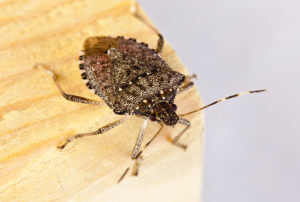Before 1996, the continental U.S. was free of brown marmorated stink bugs. This invasive species reportedly traveled from Asia and made its first U.S. appearance in Pennsylvania. This is everything you need to know about stink bugs and what you should do if you find them in your home.
What Do Stink Bugs Look Like?
Anatomy
Adult stink bugs grow to about three-fourths of an inch, are brown gray or dark green and shaped like a shield. Stink bug antennae have alternating light bands while the outer edge of the abdomen has dark bands.
bands.
Stink glands – which give the stink bug its name – are located between the first and second pair of legs and on the underside of the thorax.
Reproduction
Stink bugs typically produce one generation per year, but warmer spring and summer months could allow them to produce two or three generations. When it’s warm, female stink bugs attach a large cluster of eggs to the underside of leaves and stems. Once the eggs hatch, wingless stink bugs emerge and mature through five stages before becoming full-sized, winged adults.
What Attracts Stink Bugs?
Like most animals, stink bugs are attracted by ideal food and environmental conditions. They are mostly attracted to juicy plants, including:
- Peppers
- Citrus
- Cucumbers
- Tomatoes
- Sunflowers
- Apples
- Pears
- Plums
- Grapes
Cold-blooded stink bugs are attracted to indoor and outdoor spaces where there is ample external heat to keep them alive. They are also drawn to light colored houses and places with clear sun exposure. Inside homes, stink bugs are often found on windowsills and door frames.
Are Stink Bugs Dangerous?
Stink bugs are herbivorous, meaning they feed on fruits and crops. Because of their diet, they don’t typically bite humans unless they feel threatened.
Should an adult be bitten, they may experience a painful, harmless rash or swelling on the affected part of the body. Although stink bugs aren’t poisonous, their foul-smelling secretion can upset the gastrointestinal tract of pets, which may result in excessive drooling or even vomiting. The reaction generally isn’t severe, but pets should be discouraged from eating the bugs.
Why Are Stink Bugs a Problem?
Stink bugs aren’t much more than a nuisance for homeowners. For those in the agricultural industry, however, these insects have become a serious problem.
Stink bugs’ piercing mouthparts suck juice from fruits and cause significant damage to plants. Stink bugs are known to attack many major U.S. crops, including:
- Apples
- Peaches
- Citrus fruits
- Corn
- Tomatoes
- Soybeans
- Green peppers
The damage caused by stink bugs is often referred to as “cat facing,” and renders the affected crop unmarketable. Some growers have lost their entire crop yield because of this invasive species, and the cost to the agricultural industry as a whole is calculated to be millions of dollars.
Even worse, because stink bugs are an invasive species, they lack a natural predator. Also, there are few effective pesticides on the market labeled for use against them.
Although there is no existing solution to this relatively recent problem, scientists are currently working to find an effective way to fight the destructive pest.
How to Prevent a Stink Bug Infestation
If you are looking for simple, affordable ways to prevent stink bugs and other pests from entering your home, consider:
- Caulking inside and outside of windows
- Weather stripping entry doors
- Raking edible vegetation away from your home’s foundation
- Sealing foundation cracks
- Securing crawlspace entries
- Capping or screening the top of the chimney if your home has a fireplace
Eliminate Stink Bugs From Your Kentucky or Indiana Home
While you can attempt to keep stink bugs out yourself, the best way to ensure these pests stay away from your home is by calling a pest control professional. OPC Services offers a Stink Bug Reduction Service, which can help control the population of stink bugs in and around your home.
Let us know how we can help you by contacting us online or calling (800) 964-PEST today!